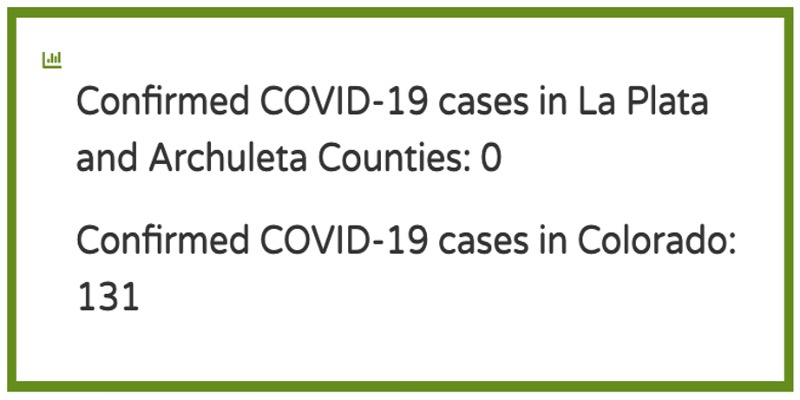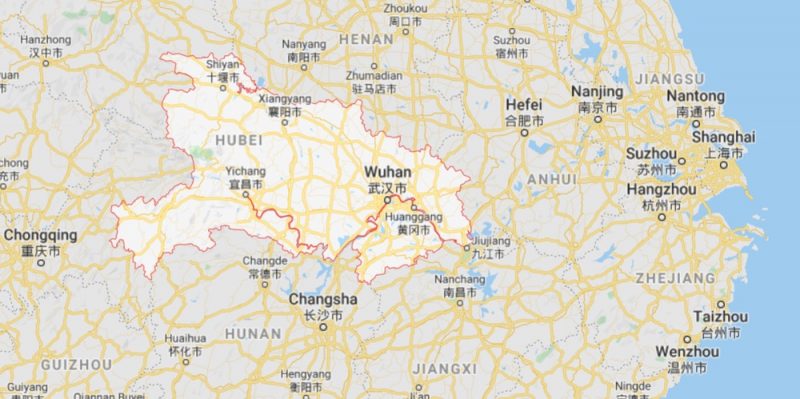Colorado Department of Public Health and Environment (CDPHE) has confirmed an additional 23 cases of individuals testing presumptive positive for COVID-19 today, as well as the state’s first death from the virus. This individual was a woman with underlying health conditions in El Paso County. As of 3/13/20 at 5 pm, La Plata and Archuleta counties have no positive cases of COVID-19.
San Juan Basin Pubic Health’s (SJBPH) Executive Director Liane Jollon said, “Our thoughts are with the family members of the individual in El Paso who died as well as everyone who has been caught up in this outbreak. We will continue working with CDPHE and our local health care providers as the health and safety of each individual in our community is our highest priority.”
The press release above arrived in our Daily Post email on Friday, March 13, at 5:22pm.
A couple of hours later, my daughter Ursala and her daughter Amelie arrived home from a kids’ birthday party and announced that there were now 11 confirmed cases of COVID-19 in Durango.
Who to believe? Your friend at a birthday party? Or the Colorado Department of Public Health and Environment?

Yesterday, the Chinese news website XINHUANET.com posted the following information about Hubei Province, where the virus was first identified last December.
China’s Hubei reports single-digit new infections of COVID-19 for four days
Central China’s Hubei Province reported four newly confirmed cases of the novel coronavirus disease (COVID-19) and 10 deaths Saturday, the provincial health commission said Sunday. All of the newly confirmed cases were reported in Wuhan, the provincial capital and epicenter of the outbreak.
The latest report brought the total confirmed COVID-19 cases in the hard-hit province to 67,794.
As of Saturday, Hubei had seen no new infections for 10 consecutive days in its 16 cities and prefectures outside Wuhan. The city of Wuhan has also seen single-digit daily increases for four days. The province also saw 1,335 patients discharged from hospital after recovery Saturday, bringing the total number of discharged patients in the province to 54,278.
Among the 9,376 hospitalized patients, 2,551 were still in severe condition and another 612 in critical condition.

Some Americans routinely discount news coming from The People’s Republic of China, under the assumption that the news is tainted by political constraints. Some of those same Americans also discount news coming from Washington DC — or from most any political entity in the US — for the same reasons.
But if we take XINHUANET as a reasonably accurate news source (based on zero evidence, other than a natural human tendency to speak the truth) we can put those numbers into some perspective.
Hubei Province has population of about 59 million people. It would appear that about 0.12 percent of the province population has contracted COVID-19 since December, with the vast majority of those cases identified within the first month.That’s one person out of every 1,000 people.
About 3,056 have died, to date, as a result of complications from the infection. That’s a fatality rate of 0.0005 percent based on an overall population of 59 million. These are reported numbers in a country where no doctor had ever seen this particular infection prior to December.
If the US, overall, were to suffer a fate similar to Hubei Province, we would see about 18,800 fatal cases of COVID-19 over the next 3 months. But that number would assume that US doctors started off knowing nothing at all about the disease nor about effective treatment.
This could be compared to the number of people killed by medical mistakes made in US hospitals, which has been variously estimated at more than 200,000 deaths per year. A John Hopkins Medicine study from 2016, headed by Johns Hopkins surgeon Dr. Martin Makary, claimed that medical errors were the third leading cause of death in America, behind cancer and heart disease, but ahead of respiratory disease.
From a 2016 article by NPR:
But no one knows the exact toll taken by medical errors. In significant part, that’s because the coding system used by CDC to record death certificate data doesn’t capture things like communication breakdowns, diagnostic errors and poor judgment that cost lives, the study says.
“You have this over-appreciation and over-estimate of things like cardiovascular disease, and a vast under-recognition of the place of medical care as the cause of death,” Makary said in an interview. “That informs all our national health priorities and our research grants.”
The analysis was published Tuesday in The BMJ, formerly the British Medical Journal…
We’ll do our best to provide Daily Post readers with a local perspective on COVID-19 as the situation continues to unfold. Perspective is important. So we’ll end this Part Seven with an excerpt from a curious story by reporter Annie Karni posted in The New York Times on Friday, March 13:
There was one big question looming on Friday over the Rose Garden, where President Trump held an afternoon news conference and announced new emergency measures to combat the spread of the coronavirus. As Mr. Trump introduced a line of chief executives and public health officials, praising their efforts and those of his administration, the mystery was the president’s own health. Would Mr. Trump, 73, be tested after interacting with a Brazilian official who tested positive for the virus just days after meeting with him in Florida?
On an issue that seemed cut and dry — yes or no — Mr. Trump hedged.
First he insisted that he did not have any symptoms, and noted that getting tested might set a bad example. “We don’t want people without symptoms to go and do the test,” he said.
Then a reporter questioned whether Mr. Trump was disregarding the advice of Dr. Anthony S. Fauci, the public health official standing directly to his right, who has recommended tests and self-quarantining for anyone who stood next to someone who had tested positive.
“I think they shouldn’t be jumping to get the test unless it’s necessary, but I think they have to listen to their doctors,” the president said.
But when pressed again on the issue, Mr. Trump equivocated. In fact, he said, he did plan to get tested “fairly soon,” but not because of his exposure to an infected individual.
“Not for that reason,” he said, without providing another reason for the test that until now he appears to have resisted. “I think I will do it anyway. Fairly soon. We’re working out a schedule.”
But hours later, just before midnight, the White House physician released a statement saying Mr. Trump would not be tested — nor would he self-quarantine — even as it became apparent that he had interacted with not one but with at least two infected members of the Brazilian delegation that visited his Mar-a-Lago estate in Florida last weekend…

